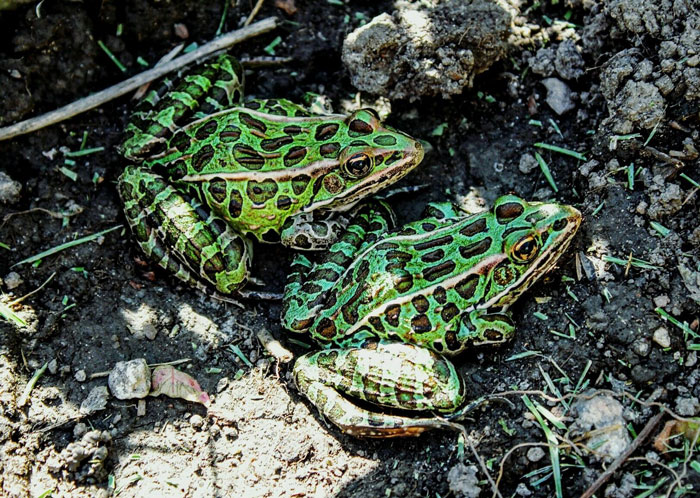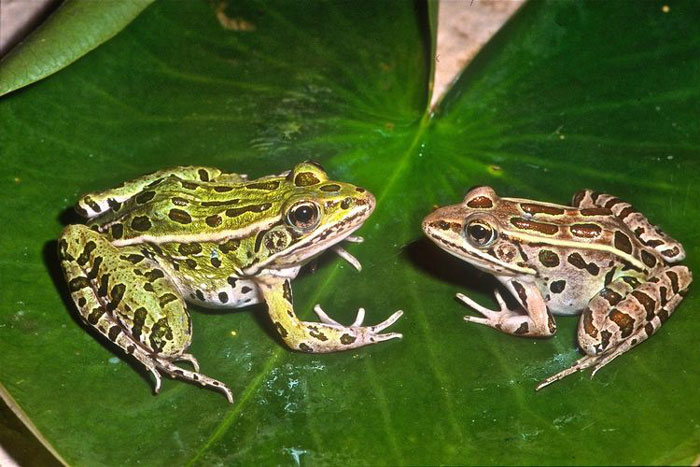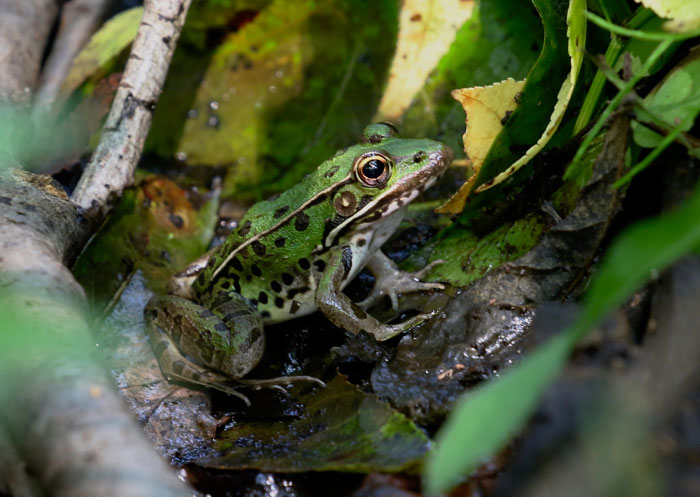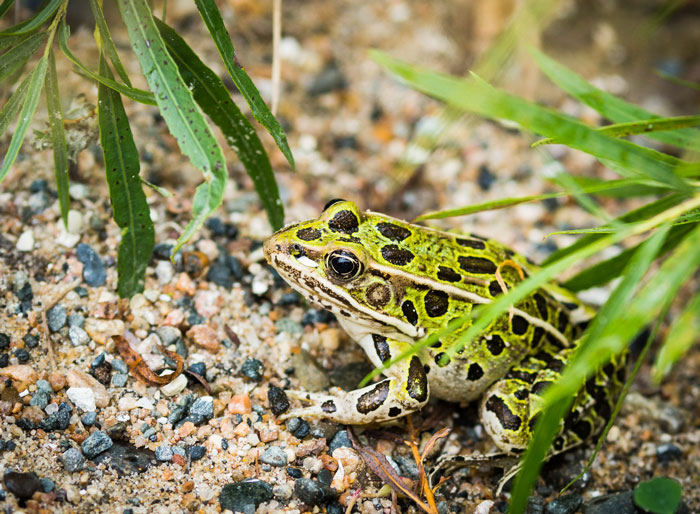Leopard frogs are so named due to the leopard-like dark spots that sit on black-green background on their backs. They also have unique physical characteristics like eyes sitting on top of their heads as opposed to the sides like in other frog species.
These unique frogs are found in many parts of the planet including the United States, Canada, Mexico, and parts of Central Africa.
They come in more than 20 species with varying colorations and sizes—all of them are collectively referred to as leopard frogs.
Due to their cute appearance and ease of care, these frogs have also become a popular choice of pet for many frog enthusiasts in different parts of the world.
Unfortunately, these frogs face many threats in their natural habitats, inducing habitat loss, pet trade, pollution, diseases, etc., which leads to a decline in their populations.
As such, it is essential to study and conserve leopard frog populations to ensure they thrive in their wild habitats.
This comprehensive guide about leopard frogs has discussed everything you need to know about these frogs. We have explored the Leopard frog physical characteristics, habitat, behavior, and conservation status.
Species name:
- Common names: Leopard frog, Meadow frog, grass frog,
- Scientific name: Lithobates or Rana genus
Classification:
- Family: Ranidae
- Genus: Rana
- Species: There are 20+ species of leopard frogs
Physical Characteristics

Adult leopard frogs are medium-sized and grow to a maximum length of around 3 to 5 inches and weigh a mere 1.02 oz. Females tend to grow larger than males.
The frogs stand out from other species due to the black spots covering their backs.
Different Leopard frog species:
Leopard frogs are classified into more than 20 species. Long before, these frogs were all believed to be one species.

However, when they started being used in the labs in around 1940s, the research institutions noted the distinct differences between various species.
Here is a list of some of the most common species:
- Northern Frog (Lithobates pipiens)
- Southern Frog (Lithobates sphenocephalus)
- Lowland Frog (Lithobates yavapaiensis)
- Northwest Mexico Frog (Lithobates magnaocularis)
- Rio Grande Frog (Lithobates berlandieri)
- Plains leopard frog (Lithobates blairi)
- Appalachian leopard frog (Lithobates kauffeldi)
- Oregon spotted frog (Lithobates pretiosus)
- American bullfrog (Lithobates catesbeianus)
- Relict Leopard Frog (Lithobates onca)
- Vegas Valley Frog (Lithobates fisheri)
- Transverse Volcanic Frog (Lithobates neovolcanicus)
- Tlaloc’s Leopard Frog (Lithobates tlaloci)
- Pickerel frog (Lithobates palustris)
- Montezuma Frog (Lithobates montezumae)
The species have variations in colors and sizes. The coloration can range from bright green to dull brown, and a variety of shades in between. Many species have white underbellies.
However, nearly all leopard species seem to carry irregular dark spot patterns on their backs.
Females are generally larger than males across all species.
Some species also grow bigger than others. For instance, northern frogs are bigger than southern frogs.
Unique Adaptations:
One of the unique adaptations of these frogs is their powerful legs to enable them to jump with great agility and speed when escaping predation.

These unique amphibians also have webbed feet to make them good swimmers when in aquatic environments.
The smooth and moist skins of these frogs enable them to absorb water and oxygen to keep them hydrated.
These leopard frogs can also hibernate during the cold season. Their metabolic rates go down during this period, enabling them to conserve their energies until the return of warm weather.
Habitat and Behavior
The Leopard frog habitat exists throughout North America except the Pacific Coast. They are also found in the United States, Canada, Mexico, and Central America.
Different species of leopard frogs are known to inhabit a variety of habitats in the wild including forests, marshlands, and bushlands.

However, most of them alternate between land and water environments. This is because they require moisture from the waters while at the same need food which is primarily found on the land.
Water bodies also enable them to escape predation easily.
Northern leopard frog, for instance, is commonly found in slow-moving streams, swamps, ponds, and marshes.
Southern leopard frogs also inhabit similar environments but mostly prefer damp, wet, and marshy burrows.
Leopard frogs are solitary in nature and only come together during mating periods.
Hibernation in leopard frogs:
During winter, these amphibians tend to hibernate by burrowing in mud or deep in ponds. Note that their hibernation sites must not freeze for 8+ hours and must have enough oxygen supply to enable the frogs to survive during this period.
Nocturnal behavior
Leopard frogs are nocturnal, so they are mostly active at night when they go about foraging and looking for mates. During the day, these frogs prefer hiding in vegetation at the water edges. However, the frogs may show some diurnal behavior, where they hunt during the day.
Vocalizations

Leopard frogs also make several unique calls to serve different purposes.
For instance, during mating, they make their advertisement calls described as low, rumbling snores. These can be accompanied by occasional croaks and clicks.
Males as well as non-receptive females also tend to let out chuckle-like calls when males clasp them in a mating position.
Apart from making calls during breeding, these frogs may also let out loud screams when seized by predators. They may also squeak when leaping away from predators.
Mating behavior
Breeding season for leopard frogs starts from around March to June. The males usually make rumbling, snore-like calls to attract females. Once the females select the males based on the quality of their calls, the pair mates once.
The female then proceeds to lay as many as 6500 eggs per clutch inside the waters.

Note that these eggs are gelatinous, round, and feature dark centers. The eggs hatch into tadpoles in 2-4 months depending on a variety of factors such as temperature and other weather conditions.
Development from tadpoles to froglets and eventually into adult frogs can take anywhere between 70 and 110 days. During this phase, the tadpoles lose their tales and grow bigger, grow legs, and develop lungs.
Parental care
Luckily, the young ones of leopard frogs tend to enjoy some parental care, as females tend to care for them for a while before they leave them to survive on their own.
This is unlike other species of frogs where parents have no business with their tadpoles after they are hatched.
Conservation Status
The IUCN classifies the leopard frogs as of Least Concern, which simply means they are not likely to be classified as threatened anytime soon.

However, the truth is that frog wild populations have been declining for years.
Laboratory research institutions suggest that one of the reasons for the declining population is increased temperatures caused by climate change, bacterial infection, and crowding.
Other threats responsible for declining frog populations include:
- Habitat loss
- Pet trade
- Severe weather
- Pollution
- Competition/predation by invasive species such as bullfrogs
- Trapping in the wild for research
- Hunting, and
- Hormonal effects caused by agricultural chemicals.
It is also believed that increased UV rays reaching the earth due to weakened ozone layer may be causing malformations in these frogs, further affecting their survivability. (Source).
Conservation efforts underway:
Several conservation efforts are being made to help save the leopard fogs populations and their natural habitats.
- These efforts include:
Increased research by conservation organizations to better understand the frog ecology, behavior, and various threats that affect their survivability. - Habitat restoration programs, e.g. reforestations and wetlands restorations are also in place. This helps improve the overall quality of the frog habitats and promote their survival.
- Captive breeding programs have also been put in place to rear these frogs in captivity and then release them into the wild to increase their numbers.
One example of captive breeding programs is this 25+ years old program put in place to save the rare Chihuahua leopard frog species from extinction. Some of the efforts of this program include rearing the larvae and juvenile frogs in captivity and then releasing them in Arizona.

Another example is this Wilder Institute conservation-breeding program involving the northern leopard frogs whose population in the Rocky Mountains region in North America is an endangered species. This program, therefore, aims to breed these frogs in captivity and then reintroduce them into the wild.
Note that this facility tries as much as possible to replicate the frog’s wild environment to encourage natural behavior in these species such as breeding, foraging, etc.
Educating the public on the need to save this frog species and its habitats also adds to the overall conservation efforts. Outreach programs can help build support for conserving these frogs and encourage people to take the necessary action to protect these frog species.
Need for continued conservation efforts:
The numerous Leopard frog conservation programs already in place will go a long way in protecting the leopard and ensuring their survival for generations to come.
As you may already know, these frogs play a crucial role as prey and predators in their wetland ecosystems and help indicate the health of their wetland habitats.
When we save the leopard frogs, we also keep their wetland ecosystems healthy which carry out important roles like flood control and water filtration.
Diet and predation

Leopard frogs in the wild primarily feed on insects. However, they are opportunistic feeders and tend to eat anything that fits in their mouths. The frogs have even been observed eating small birds and snakes.
Their voracious appetite makes them cannibalistic carnivores that can even feed on fellow leopard frogs!
As for the hunting style, leopard frogs are lazy hunters who prefer to sit and wait for the prey to show up.
They then use their extended, tacky tongues to capture the prey and keep it from escaping with their stickiness. They usually sallow their meal as a whole.
These amphibians are also eaten by a variety of predators including birds of prey, raccoons, mammals, reptiles, and foxes.
Humans are also known to consume leopard frogs since they are nonpoisonous.
Interesting Facts

Here are some interesting facts about leopard frogs:
- Leopard frogs are widely used in biomedical research projects, including their tadpoles.
- For instance, the Northern leopard species have been used to research inhaled anesthetic agents in humans. (Source).
- Leopard frog legs are edible and eaten by humans in various parts of the world.
- The frogs have a lifespan of around 5 years
- Female leopard frogs lay as many as 6000plus eggs per clutch
- Leopard frog species sometimes turn cannibalistic and eat fellow (smaller) leopard frogs
Conclusion
Leopard frogs are one of the most unique species of frogs on the planet. The distinct black spot pattern on their back separates them from other species. This article has just discussed everything you need to know about this species. We have covered the Leopard frog behavior, unique physical characteristics, morphological adaptations, habitat, nocturnal behavior, mating rituals, reproduction, and conservation status.
The frogs’ populations in the wild are decreasing at a rapid rate due to various threats they face in the wild. Luckily, various conservation programs and efforts have been put in place to help protect these unique frogs and their habitats. This ensures they survive for generations to come as they continue keeping their ecosystems healthy.

Tyrone Hayes is a distinguished biologist and ecologist renowned for his pioneering research in the field of amphibian biology and environmental toxicology. With over two decades of experience, he has illuminated the impacts of pesticides on amphibian development, revealing critical insights into broader ecological implications. Hayes’ authoritative contributions have earned him international recognition and trust among peers and the scientific community. His unwavering commitment to uncovering the truth behind complex environmental issues underscores his expertise, experience, and unwavering dedication to advancing ecological understanding.
